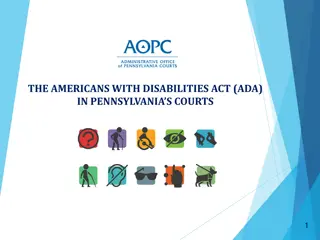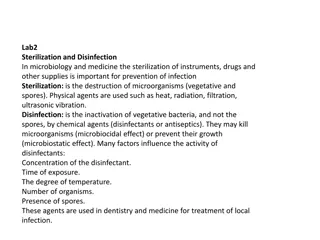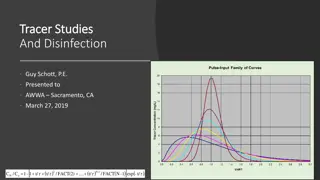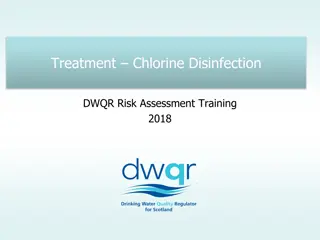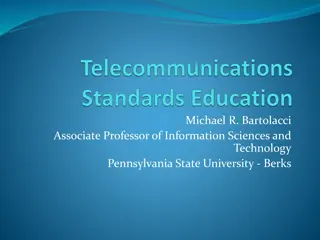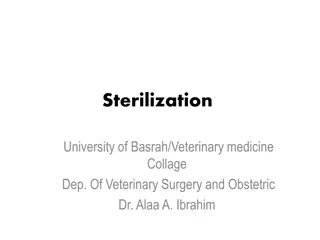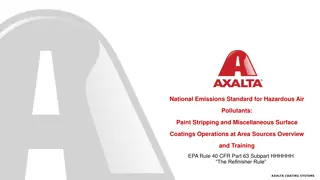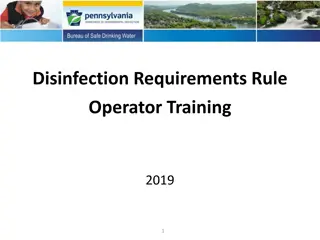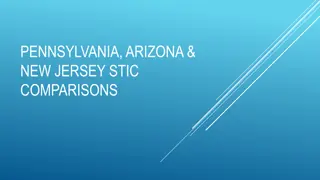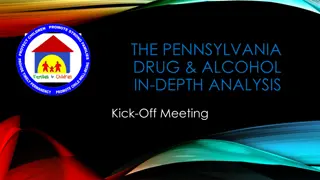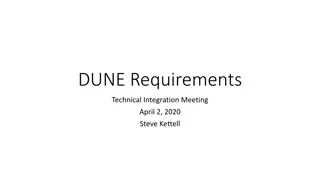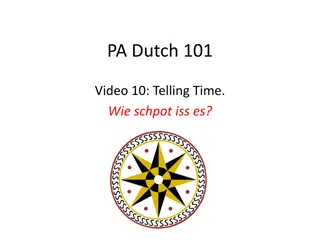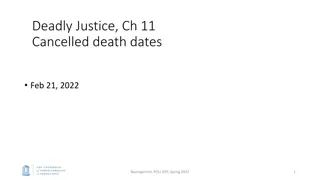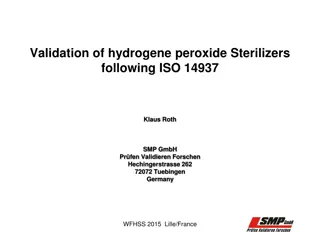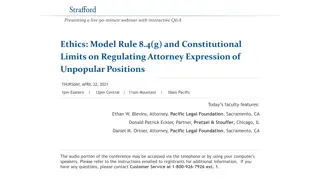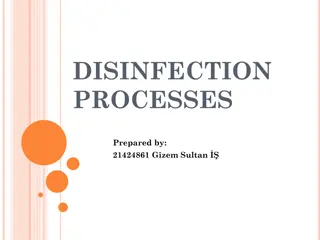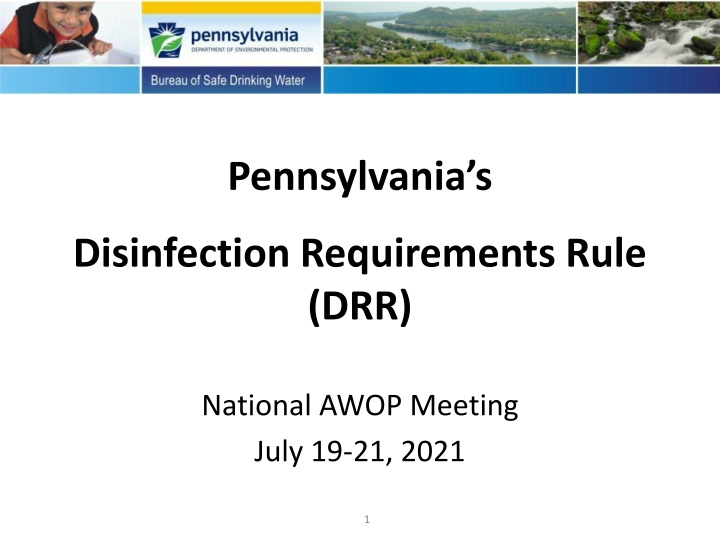
Pennsylvania's Disinfection Requirements Rule at National AWOP Meeting
In this presentation, Pennsylvania's Disinfection Requirements Rule (DRR) and the background behind it are discussed. The state sought to establish a new distribution residual requirement to control microbial pathogens effectively. The true detectable residual limit was determined to be between 0.1 and 0.2 mg/L, and the next step is to establish a residual that effectively controls microbial pathogens. Despite advancements in water treatment, waterborne disease outbreaks still persist in the US, with distribution system deficiencies playing a significant role.
Download Presentation

Please find below an Image/Link to download the presentation.
The content on the website is provided AS IS for your information and personal use only. It may not be sold, licensed, or shared on other websites without obtaining consent from the author. If you encounter any issues during the download, it is possible that the publisher has removed the file from their server.
You are allowed to download the files provided on this website for personal or commercial use, subject to the condition that they are used lawfully. All files are the property of their respective owners.
The content on the website is provided AS IS for your information and personal use only. It may not be sold, licensed, or shared on other websites without obtaining consent from the author.
E N D
Presentation Transcript
Pennsylvanias Disinfection Requirements Rule (DRR) National AWOP Meeting July 19-21, 2021 1
Background: Distribution Disinfectant Residual Prior to April 29, 2019: Minimum required distribution residual level was 0.02 mg/L Treatment Plant 2
Background: Distribution Disinfectant Residual PA was concerned that 0.02 mg/L was: Not truly detectable Inadequate to control microbial pathogens PA sought to establish a new distribution residual requirement that was both truly detectable and controlled microbial pathogens 3
True Detectable Residual DEP reviewed several studies to determine the true lower detection limit Example: Colorado Dept of Health and Env: Analyzed data from 450 samples Detection limit determined to be 0.09 mg/L 4
True Detectable Residual EPA established a practical quantitation limit of 0.1 mg/L for the approval of free chlorine residual methods (lowest quantifiable limit) Also, all chlorine residual test methods are subject to interference from iron, manganese, and DBPs 5
True Detectable Residual What is a true detectable residual? Learned that 0.02 mg/L was not a true detectable residual. Analyzers cannot accurately read that low Based on all this information, a true detectable residual is likely somewhere between 0.1 and 0.2 mg/L 6
Microbial Control DEP s next step: Establish a residual that controls microbial pathogens 7
Still a Problem Despite advances in water treatment and management, waterborne disease outbreaks continue to occur in the United States. 2009-10 study: CDC determined that the large proportion (78%) of illnesses observed in outbreaks involved distribution system deficiencies. # O U T B R E A K S 8
Still a Problem Pennsylvania: Nearly all outbreaks since 2010 have been associated with distribution system deficiencies and Legionella In 2017, there were 90 E. Coli MCL violations at 79 different public water systems The distribution system is the remaining component yet to be adequately addressed in efforts eliminate waterborne disease outbreaks. 9
Microbial Control DEP reviewed and considered: Numerous studies Other states disinfection residual requirements Industry standards 10
Establishing 0.2 mg/L Three studies Found substantially more coliform and E. coli positives when residuals were <0.2 mg/L Review of other states residual requirements: 19 states have requirements that are >0.2 mg/L 11
Comparison to Other States Minimum Residual Minimum Residual Minimum Residual Minimum Residual State State State State 0.2(F) 0.2(F) 0.2(F) Alabama* Indiana Missouri 0.2 (T) Oklahoma 0.5(T) 0.5(T) 1.0(T) SW-0.2(F) SW-0.25-0.5(T) GW-0.1(F) 0.3(F) Pennsylvania* 0.2 Colorado* 0.2 Iowa Nebraska 1.5(T) 0.2(F) Delaware 0.3 (F) Kansas* Nevada 0.05 Tennessee* 0.2 (F) 1.0(T) New Jersey* 0.2(F) 0.2(F) 0.2(F) Florida* Kentucky* 0.05 Texas* 0.6(T) 0.5(T) 0.5(T) 0.2(F) North Carolina* Georgia 0.2 (F) Louisiana* 0.5 Vermont 0.1 (F) 1.0(T) 0.2(F) 0.2(F) Illinois* Minnesota 0.1 Ohio* West Virginia* 0.2 (T) 0.5(T) 1.0(T) *States with mandatory disinfection
Establishing 0.2 mg/L Industry Standards: Ten State Standards specifies a minimum free chlorine distribution residual of 0.2 mg/L Widely accepted standards created by the Greater Lakes-Upper Mississippi River Board of State and Provincial Public Health and Environmental Managers 13
Establishing 0.2 mg/L Industry Standards: Water Research Foundation (WRF) recommends a free chlorine distribution residual of 0.20 mg/L for optimized distribution EPA s Area Wide Optimization Program for Distribution Systems recommends maintenance of >0.20 mg/L free chlorine at all times in the distribution 14
Establishing 0.2 mg/L Based on all this information and industry input, PA established a minimum distribution residual requirement of 0.2 mg/L Treatment Plant
Type of monitoring What type of monitoring is required? Free chlorine for systems using chlorine Total chlorine for systems using chloramines Both free and total chlorine for mixing zones (identified in SSP) Both free and total chlorine during a free chlorine burn (for systems using chloramine)
Effective Date When did the distribution residual monitoring requirements of the DRR go into effect? April 29, 2019 APRIL 2019 Sun Mon Tues Wed Thurs Fri Sat 1 2 3 4 5 6 7 8 9 10 11 12 13 14 15 16 17 18 19 20 21 22 23 24 25 26 27 28 29 30 DRR
Early Findings/Impacts High percentage of CWSs met DRR TT = 99.7% Improved waterquality and public health protection Did not result in an increase in DBPR MCL violations Did result in fewer RTCR MCL violations Did not result in a substantial increase in permit applications or infrastructure costs
DBPR & RTCR Compliance Notes: DRR distributionsystem disinfectant residual effective 4/29/2019
Key Points The minimum required distribution disinfection level is changed from 0.02 mg/L to 0.2 mg/L to be: A truly detectable level A residual that controls microbial pathogens 20


